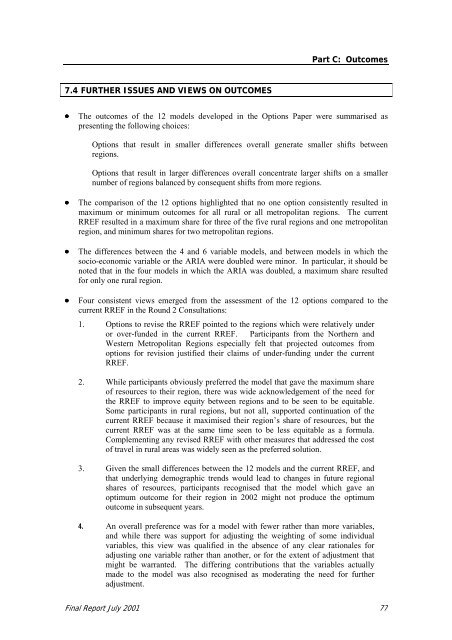Final Report on RREF 2001 - Department of Health
Final Report on RREF 2001 - Department of Health
Final Report on RREF 2001 - Department of Health
Create successful ePaper yourself
Turn your PDF publications into a flip-book with our unique Google optimized e-Paper software.
Part C: Outcomes<br />
7.4 FURTHER ISSUES AND VIEWS ON OUTCOMES<br />
• The outcomes <strong>of</strong> the 12 models developed in the Opti<strong>on</strong>s Paper were summarised as<br />
presenting the following choices:<br />
Opti<strong>on</strong>s that result in smaller differences overall generate smaller shifts between<br />
regi<strong>on</strong>s.<br />
Opti<strong>on</strong>s that result in larger differences overall c<strong>on</strong>centrate larger shifts <strong>on</strong> a smaller<br />
number <strong>of</strong> regi<strong>on</strong>s balanced by c<strong>on</strong>sequent shifts from more regi<strong>on</strong>s.<br />
• The comparis<strong>on</strong> <strong>of</strong> the 12 opti<strong>on</strong>s highlighted that no <strong>on</strong>e opti<strong>on</strong> c<strong>on</strong>sistently resulted in<br />
maximum or minimum outcomes for all rural or all metropolitan regi<strong>on</strong>s. The current<br />
<strong>RREF</strong> resulted in a maximum share for three <strong>of</strong> the five rural regi<strong>on</strong>s and <strong>on</strong>e metropolitan<br />
regi<strong>on</strong>, and minimum shares for two metropolitan regi<strong>on</strong>s.<br />
• The differences between the 4 and 6 variable models, and between models in which the<br />
socio-ec<strong>on</strong>omic variable or the ARIA were doubled were minor. In particular, it should be<br />
noted that in the four models in which the ARIA was doubled, a maximum share resulted<br />
for <strong>on</strong>ly <strong>on</strong>e rural regi<strong>on</strong>.<br />
• Four c<strong>on</strong>sistent views emerged from the assessment <strong>of</strong> the 12 opti<strong>on</strong>s compared to the<br />
current <strong>RREF</strong> in the Round 2 C<strong>on</strong>sultati<strong>on</strong>s:<br />
1. Opti<strong>on</strong>s to revise the <strong>RREF</strong> pointed to the regi<strong>on</strong>s which were relatively under<br />
or over-funded in the current <strong>RREF</strong>. Participants from the Northern and<br />
Western Metropolitan Regi<strong>on</strong>s especially felt that projected outcomes from<br />
opti<strong>on</strong>s for revisi<strong>on</strong> justified their claims <strong>of</strong> under-funding under the current<br />
<strong>RREF</strong>.<br />
2. While participants obviously preferred the model that gave the maximum share<br />
<strong>of</strong> resources to their regi<strong>on</strong>, there was wide acknowledgement <strong>of</strong> the need for<br />
the <strong>RREF</strong> to improve equity between regi<strong>on</strong>s and to be seen to be equitable.<br />
Some participants in rural regi<strong>on</strong>s, but not all, supported c<strong>on</strong>tinuati<strong>on</strong> <strong>of</strong> the<br />
current <strong>RREF</strong> because it maximised their regi<strong>on</strong>’s share <strong>of</strong> resources, but the<br />
current <strong>RREF</strong> was at the same time seen to be less equitable as a formula.<br />
Complementing any revised <strong>RREF</strong> with other measures that addressed the cost<br />
<strong>of</strong> travel in rural areas was widely seen as the preferred soluti<strong>on</strong>.<br />
3. Given the small differences between the 12 models and the current <strong>RREF</strong>, and<br />
that underlying demographic trends would lead to changes in future regi<strong>on</strong>al<br />
shares <strong>of</strong> resources, participants recognised that the model which gave an<br />
optimum outcome for their regi<strong>on</strong> in 2002 might not produce the optimum<br />
outcome in subsequent years.<br />
4. An overall preference was for a model with fewer rather than more variables,<br />
and while there was support for adjusting the weighting <strong>of</strong> some individual<br />
variables, this view was qualified in the absence <strong>of</strong> any clear rati<strong>on</strong>ales for<br />
adjusting <strong>on</strong>e variable rather than another, or for the extent <strong>of</strong> adjustment that<br />
might be warranted. The differing c<strong>on</strong>tributi<strong>on</strong>s that the variables actually<br />
made to the model was also recognised as moderating the need for further<br />
adjustment.<br />
<str<strong>on</strong>g>Final</str<strong>on</strong>g> <str<strong>on</strong>g>Report</str<strong>on</strong>g> July <strong>2001</strong> 77
















